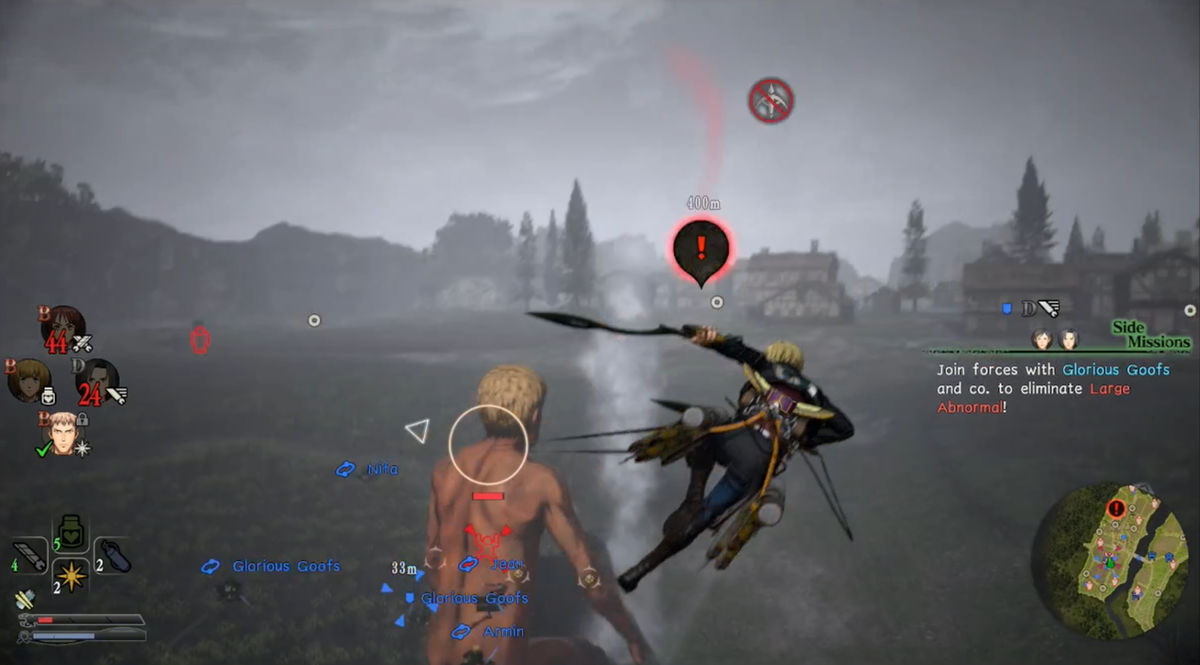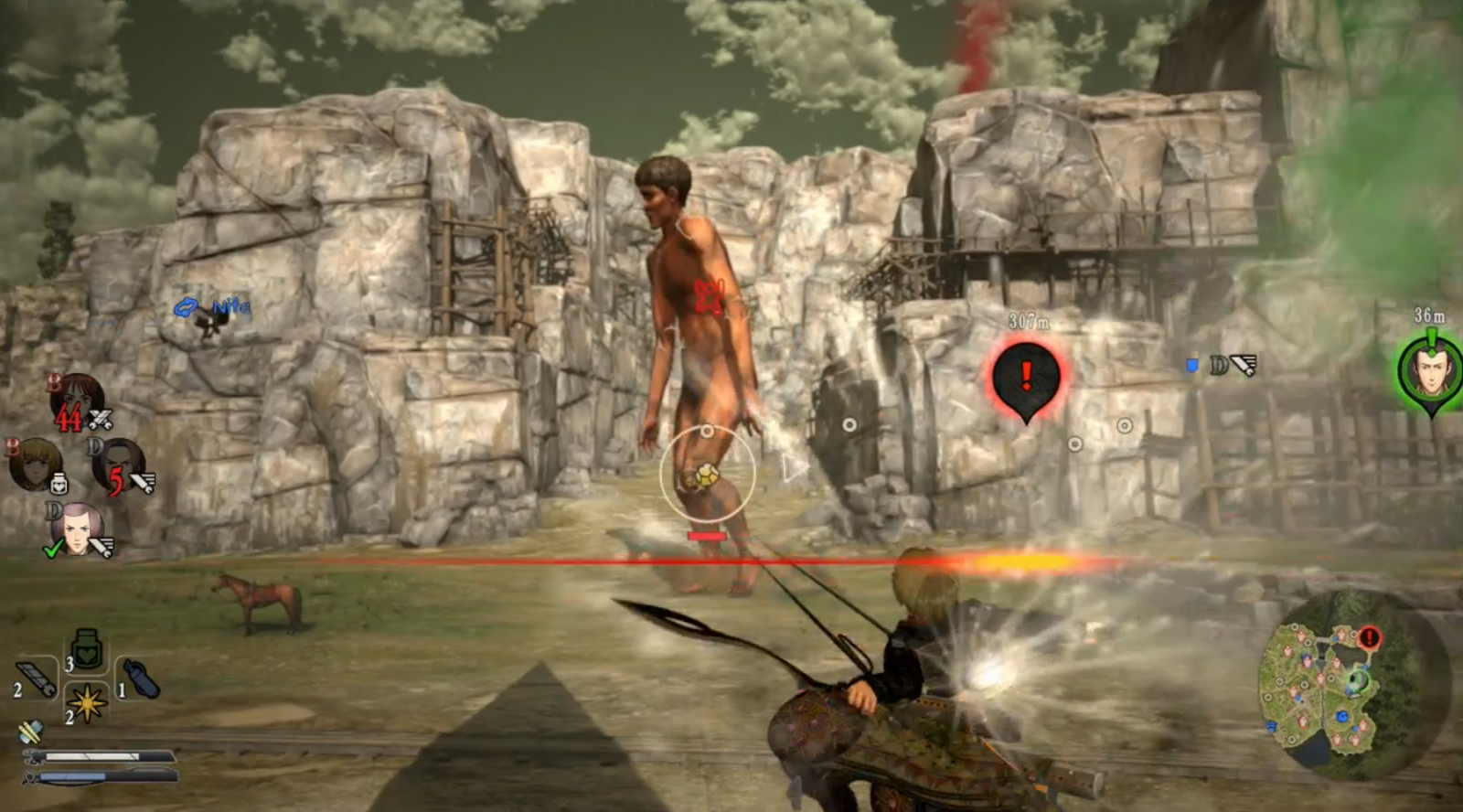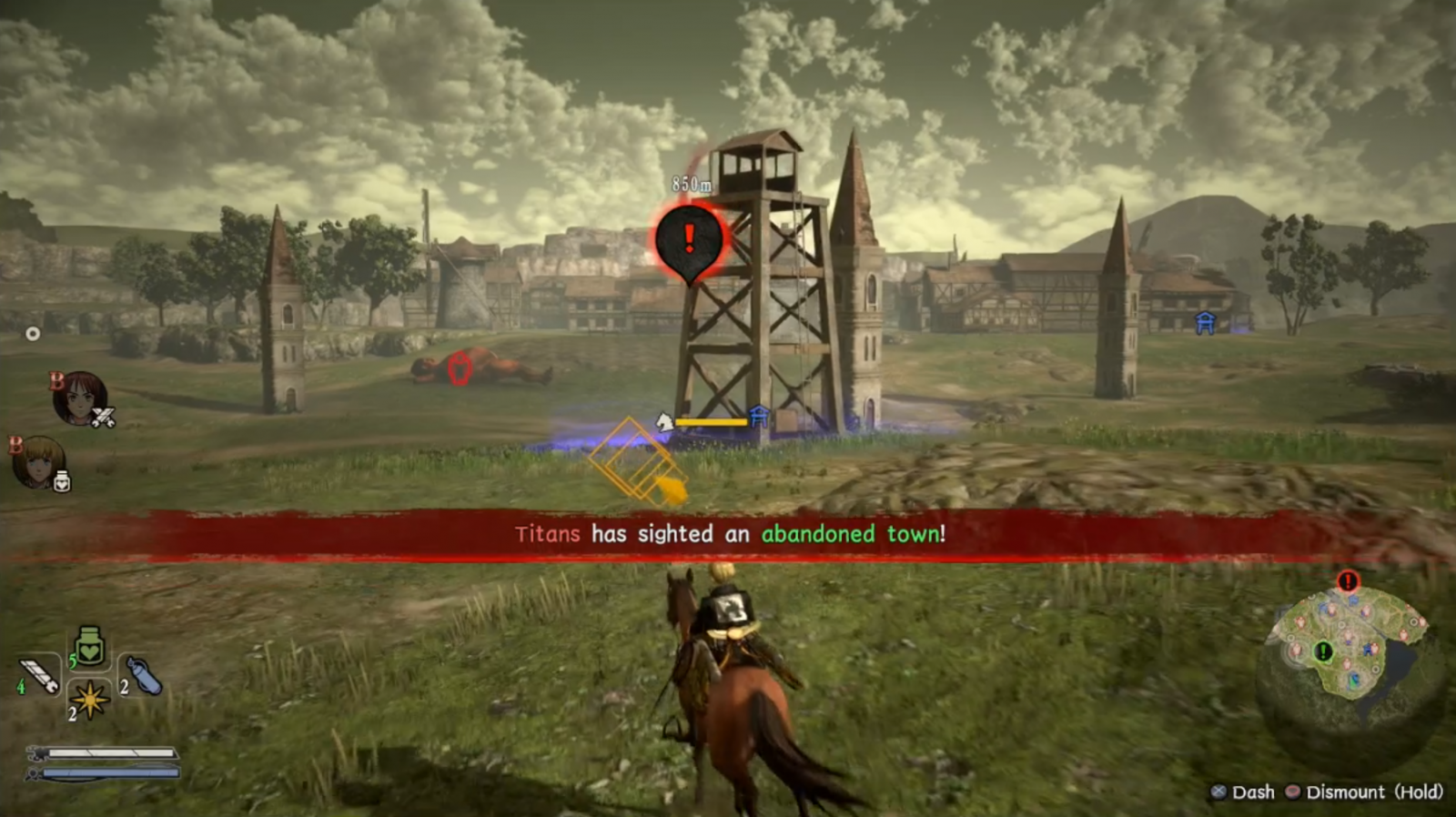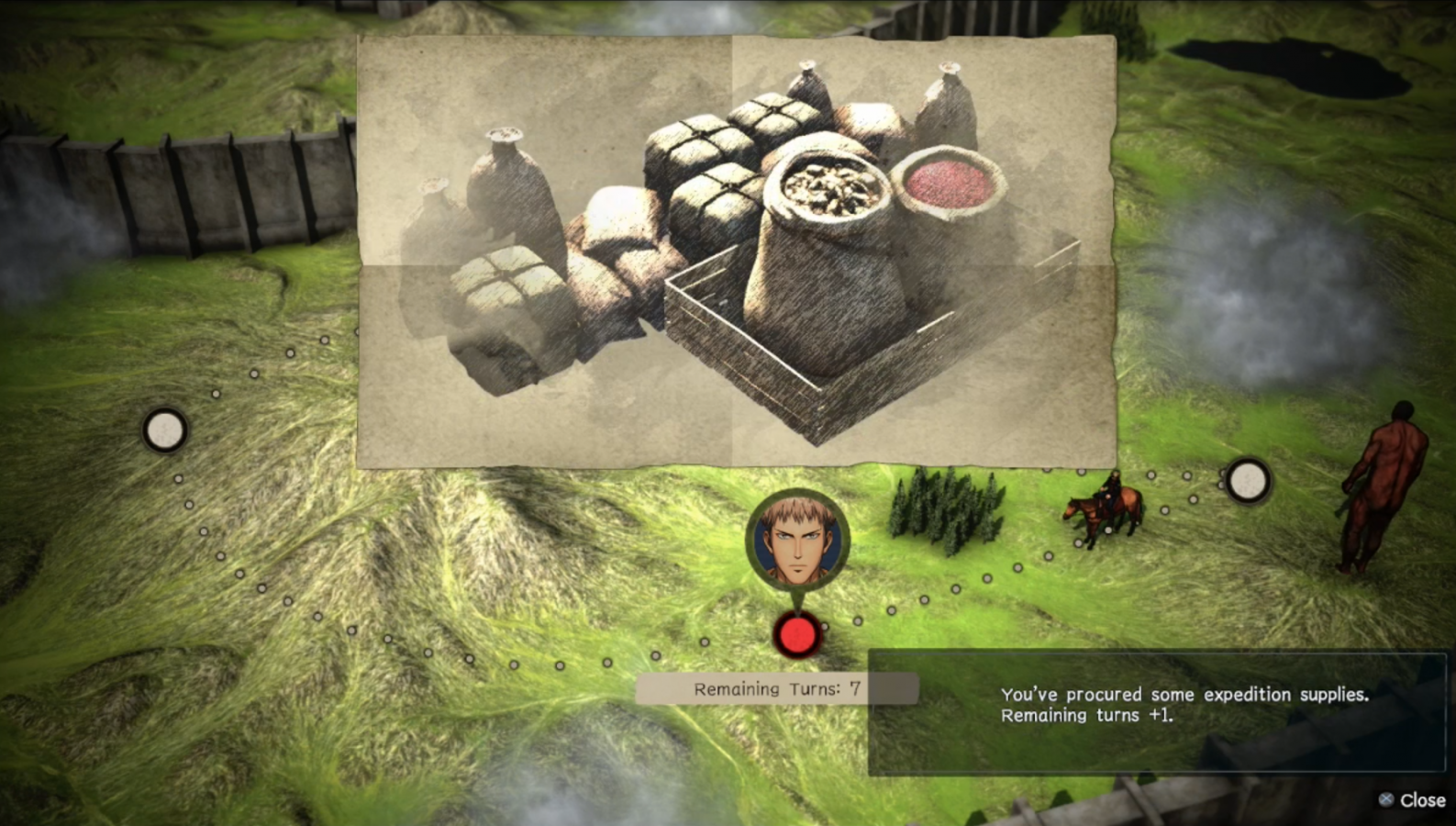
Humanity has lived in fear of massive, dangerous creatures known as the Titans for many years. These humanoid creatures wander around, seemingly mindless, driven by their sole desire to feed. Mankind has walled off its cities in the hopes of protecting itself from the Titans, but at the same time venture out with the hope of discovering a way to eliminate them for good. Join Eren, Armin, Mikasa, and co. as they fight for humanity’s sake in this death-filled, high-stakes story.
The game follows the story from the manga or show, of which I’ve only experienced the latter. It starts at the beginning of the series and leads into season three. There are two different modes that revolve around the original plot, with Story mode placing you in the role of an original character who is treated as if they were in the series the whole time, and Character Episode mode letting you experience the story from the point of view of various important characters such as Levi, Armin, and more. Both modes cut out a fair amount of trivial things and focus on hitting the key events of the series. I liked that because I’d rather not have the game padded with the video game version of filler episodes.

As for the game’s main focus, the combat, I was a bit nervous at first about how they would implement the omni-directional movement gear for the game, otherwise known as ODM gear, but they did a great job. It takes a few minutes to get the hang of things, but it doesn’t take long before you’ll be zipping through the air like a boss. You don’t need to aim to activate the anchors; you just hit square and the game aims and launches accordingly. When your anchors are hooked in, you can use the left stick to move around. The movement of the characters is pretty fluid, and if you’ve gotten good at using your ODM gear, then you’ll be soaring through the treelines and over rooftops without slowing down. You can even do an extra jump in the air and do a short boost to help cover a bit more distance.
As anyone who’s familiar with the series knows, the only way to kill a Titan is by slicing through the nape of its neck. The same thing rings true here. Thankfully, you must lock onto your target before attacking, which helps your aim quite a bit. That doesn’t mean that you’ll get a perfect hit every time. You’ll still need to manuever your character accordingly in order to get the right angle and get a clean strike. Sometimes it’s to correct a bad angle, and other times it’s to adjust for a Titan turning around and attacking. It should be stated that Titans won’t always go down from one slice to the nape. The smaller ones will likely die, but the bigger they are, the more damage you’ll need to do in order to kill them. Each body part on a Titan, including the nape, has a health bar, so it’s pretty easy to keep track of how successful your attacks are. Speaking of, you can work on dismembering Titans in order to gain extra materials from them or even just to make it easier to go for the nape.

Another important aspect carried over from the series is blade durability and gas supplies. You can track them via meters in the bottom left corner of the screen that you need to keep an eye on. Above those are your supplies that you can refill yourself with. When your blades get too dull, you need to take a second to swap them out for new, sharp ones. When your gas canister runs out, you need to take a few seconds to swap in a full canister. Not changing your blades results in you doing little to no damage from attacks, while running out of gas drastically hinders your ability to traverse. You can still use ODM gear to move around, but you won’t be able to boost or increase your speed.
Don’t worry though, because there are stations around the battlefields that can be used to build small bases. If you have a construction signal, you can use it to quickly create a resupply station in that area. Supply bases let you refill supplies, although there’s a cooldown between each resupply. You can also create artillery stations, watchtowers, and more. I prefer the supply bases because they are your only way of keeping your supplies in check. You can get construction signals by helping out comrades who send out distress signals. Head to their location, help them wipe out the Titans they are facing, and not only will they join you during the mission, but you’ll be rewarded with a construction signal. This is even more of an incentive to go help out comrades around the battlefield.

Story mode lets you create your own character, male or female, and take them on their own journey to become a Titan slaying machine. You’ll start off in basic training alongside Eren and the others, following their stories as well as your own. You interact with key characters constantly, but it’s done in a way that doesn’t feel like you were just shoehorned in. For the game, it feels like you’re very important to the cause, but if you took your character out, then the story would still be able to continue as normal. In other words, you don’t need to worry about your character’s existence creating plot holes.
Story mode doesn’t just go from one battle to the next; there are hub locations to explore, characters to talk to, shops to buy from, and scout missions to embark on. Exploration doesn’t do anything besides letting you see a few locations in the A.O.T. universe, so don’t worry about trying to check every area out. Talking to characters is mostly for the sake of building relationships and unlocking new skills. If a character has a heart and hand symbol above their head, then you can talk to them. These conversations give you multiple choice answers and picking the best one for that person will fill up a good amount of their friendship meter. Whenever it fills completely, they’ll get the previous symbol with an arrow added to it. Talking to them at this point will trigger a scene where you bond more, increase their friendship rank by one, and unlock a new skill. These skills can be equipped to increase your stats and other aspects of combat. Shops allow you to use materials and regiment funds to craft new equipment and upgrade or reinforce current equipment.
Scout missions aren’t available right off the bat, but once they’re available, you can take them on in order to earn more experience, obtain more materials, build relationships with comrades, and get more combat practice. You can talk to other scouts that you know and recruit them to your team before heading out on scout missions as well. Doing so will not only give you backup, but it will improve your relationship as a result of the time spent together. It’s your call, but I’d highly recommend grabbing some good soldiers before embarking on scout missions.
Character Episode mode on the other hand doesn’t have any hub locations. It takes place on a menu consisting of crystals, with each crystal representing an event in the story. Some events are only informational cutscenes, while others let you play the role of a pivotal character in combat. Obviously the combat events are more fun, but the cutscenes are important for understanding the full story. Those who already know the story may be tempted to skip the cutscenes in order to get to the gameplay faster, and I’ll admit that after a while, I did that too. It’s not that the cutscenes are bad, it’s that I wanted to get back into the meat of the game.

Another Episode mode is my least favorite of the modes. This mode lets you play missions from other modes freely by yourself or online with other players. There are also some special multiplayer modes such as one on one showdowns, predator mode, and elimination. It’s nice being able to take on missions with other people and work together to slay Titans in the name of mankind, but it doesn’t feel as good as single player to me. You can even compete against other people in head-to-head modes, which is an interesting inclusion, but not what the game is about. I played several missions and modes without any connection issues or slowdowns, but I didn’t feel the desire to stay in this mode very long. That being said, it’s not a bad mode by any means, but I prefer staying in the realm of the story and having to prove myself as the only human player.
Territory Recovery mode places you in the role of your original character as they try to build up a main base of operations. You have a hub at your base, while the map consists of various paths and location markers. Venturing out on expeditions lets you explore the map with a limited number of turns. Each space you move costs a turn, but you can refresh turns by finding supplies on paths. Reaching a location marker allows you to engage in combat and complete a mission there. Doing so nets you experience, materials, and regiment funds like normal.

As you travel, you can find other scouts, and completing missions with them will raise your invitation meter with them. If this meter fills up, you can invite them into your regiment and bring them on missions with you from now on. You need to be careful because each character has a fatigue level, and if it gets low, they’ll be less effective in combat until they get a chance to rest. In that case, you need to remove them from the squad and wait for them to rest up. After all, you don’t want to overwork your friends, now do you? Successfully clearing out enough areas will allow you to venture out further and further, opening up the possibilities to meet new comrades and obtain better materials. At your base, you can spend regiment funds in order to improve various aspects of your regiment. You can increase the number of soldiers allowed in the regiment, increase the number of comrades you can take with you into battle, and even improve the quality of the small bases that you can build on the battlefield such as supply stations and artillery.
The game looks pretty good, the movement is fluid, and the combat is pretty entertaining. The sound design fits the tone of the A.O.T. world very well, from the soundtrack to the combat noises. I didn’t expect the game audio to be Japanese voices with English dub, but that wasn’t a big deal. For someone who has watched the show on Toonami with English voice actors, not getting the English voices was a bit of a bummer and disconnect, but the decision is understandable. When you’ve gotten used to something a certain way, it ends up being sort of jarring experiencing it in a different way. Again, not a bad thing, but something that should be pointed out nonetheless. Going back to the gameplay, even though I’ve had a great time playing the game, I have to admit that it does get a bit repetitive after playing for a few hours. I’d recommend taking plenty of breaks in order to avoid getting burnt out on the game because it is a fantastic time to be had for Attack on Titan fans. With several enjoyable modes, there’s plenty to do and keep you occupied for quite some time.
Attack on Titan 2: Final Battle
Great
Attack on Titan 2: Final Battle is a great way to experience what it's like to be in the shoes of the scout regiment as they fight for humanity's sake. With wonderfully fluid movement thanks to the ODM gear and the strategic combat, you'll want to slay as many Titans as possible. The downside is that combat does get repetitive after some time, but this can be helped by taking plenty of breaks.
Pros
- Fluid movement from ODM gear feels amazing and freeing
- Follows the story of the series and focuses on key events
- Several modes to keep you occupied and engaged
Cons
- Gameplay gets repetitive after some time
- Cutscene heavy moments take away from the action at times
